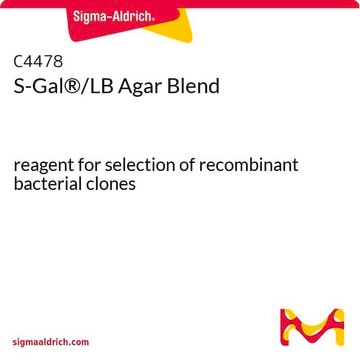16669
5-Brom-6-chlor-3-indolyl-β-D-galactopyranosid
reagent for selection of recombinant bacterial clones
Synonym(e):
Mag-Gal, Magenta-Gal
About This Item
Empfohlene Produkte
Qualität
for molecular biology
Qualitätsniveau
Sterilität
non-sterile
Assay
≥98.0% (HPLC)
Form
powder
Löslichkeit
DMF: soluble
DMSO: soluble
Eignung
suitable for β-galactosidase test
Lagertemp.
−20°C
SMILES String
OC[C@H]1O[C@@H](Oc2c[nH]c3cc(Cl)c(Br)cc23)[C@H](O)[C@@H](O)[C@@H]1O
InChI
1S/C14H15BrClNO6/c15-6-1-5-8(2-7(6)16)17-3-9(5)22-14-13(21)12(20)11(19)10(4-18)23-14/h1-3,10-14,17-21H,4H2/t10-,11-,12+,13-,14-/m1/s1
InChIKey
CHRVKCMQIZYLNM-RKQHYHRCSA-N
Allgemeine Beschreibung
Anwendung
Prinzip
Ähnliches Produkt
Lagerklassenschlüssel
13 - Non Combustible Solids
WGK
WGK 3
Flammpunkt (°F)
Not applicable
Flammpunkt (°C)
Not applicable
Persönliche Schutzausrüstung
Eyeshields, Gloves, type N95 (US)
Choose from one of the most recent versions:
Besitzen Sie dieses Produkt bereits?
In der Dokumentenbibliothek finden Sie die Dokumentation zu den Produkten, die Sie kürzlich erworben haben.
Unser Team von Wissenschaftlern verfügt über Erfahrung in allen Forschungsbereichen einschließlich Life Science, Materialwissenschaften, chemischer Synthese, Chromatographie, Analytik und vielen mehr..
Setzen Sie sich mit dem technischen Dienst in Verbindung.







